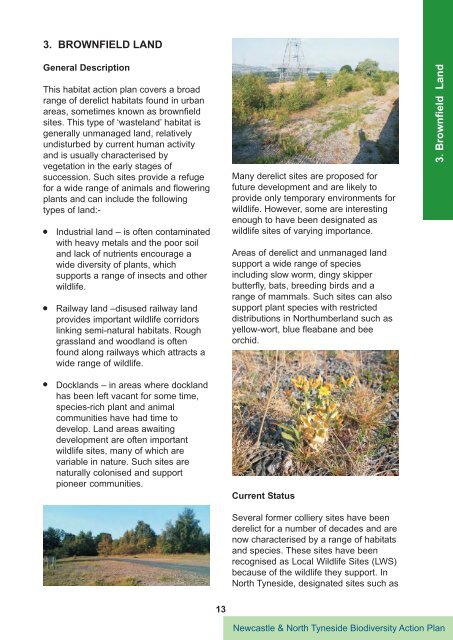III. Species Action Plans - Newcastle City Council
III. Species Action Plans - Newcastle City Council
III. Species Action Plans - Newcastle City Council
Create successful ePaper yourself
Turn your PDF publications into a flip-book with our unique Google optimized e-Paper software.
3. Brownfield Land<br />
3. BROWNFIELD LAND<br />
General Description<br />
This habitat action plan covers a broad<br />
range of derelict habitats found in urban<br />
areas, sometimes known as brownfield<br />
sites. This type of ‘wasteland’ habitat is<br />
generally unmanaged land, relatively<br />
undisturbed by current human activity<br />
and is usually characterised by<br />
vegetation in the early stages of<br />
succession. Such sites provide a refuge<br />
for a wide range of animals and flowering<br />
plants and can include the following<br />
types of land:-<br />
Industrial land – is often contaminated<br />
with heavy metals and the poor soil<br />
and lack of nutrients encourage a<br />
wide diversity of plants, which<br />
supports a range of insects and other<br />
wildlife.<br />
Railway land –disused railway land<br />
provides important wildlife corridors<br />
linking semi-natural habitats. Rough<br />
grassland and woodland is often<br />
found along railways which attracts a<br />
wide range of wildlife.<br />
Docklands – in areas where dockland<br />
has been left vacant for some time,<br />
species-rich plant and animal<br />
communities have had time to<br />
develop. Land areas awaiting<br />
development are often important<br />
wildlife sites, many of which are<br />
variable in nature. Such sites are<br />
naturally colonised and support<br />
pioneer communities.<br />
13<br />
Many derelict sites are proposed for<br />
future development and are likely to<br />
provide only temporary environments for<br />
wildlife. However, some are interesting<br />
enough to have been designated as<br />
wildlife sites of varying importance.<br />
Areas of derelict and unmanaged land<br />
support a wide range of species<br />
including slow worm, dingy skipper<br />
butterfly, bats, breeding birds and a<br />
range of mammals. Such sites can also<br />
support plant species with restricted<br />
distributions in Northumberland such as<br />
yellow-wort, blue fleabane and bee<br />
orchid.<br />
Current Status<br />
Several former colliery sites have been<br />
derelict for a number of decades and are<br />
now characterised by a range of habitats<br />
and species. These sites have been<br />
recognised as Local Wildlife Sites (LWS)<br />
because of the wildlife they support. In<br />
North Tyneside, designated sites such as<br />
3. Brownfield Land<br />
<strong>Newcastle</strong> & North Tyneside Biodiversity <strong>Action</strong> Plan

















